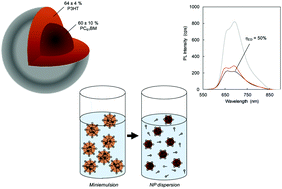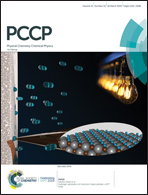Building intermixed donor–acceptor architectures for water-processable organic photovoltaics†
Abstract
A modified synthesis method for aqueous nanoparticle printing inks, based upon vacuum-assisted solvent removal, is reported. Poly(3-hexylthiophene):phenyl C61 butyric acid methyl ester nanoparticle inks were prepared via this modified miniemulsion method, leading to both an improvement in photoactive layer morphology and a substantial reduction in the ink fabrication time. A combination of UV-visible spectroscopy, photoluminescence spectroscopy and scanning transmission X-ray microscopy measurements revealed a nanoparticle morphology comprising highly intermixed donor–acceptor domains. Consistent with these measurements, dynamic mechanical thermal analysis of the nanoparticles showed a glass transition temperature (Tg) of 104 °C, rather than a pure polymer phase or pure fullerene phase Tg. Together the spectroscopy, microscopy and thermomechanical data indicate that rapid solvent removal generates a more blended nanoparticle morphology. As such, this study highlights a new experimental lever for optimising nanostructure in the photoactive layer of nanoparticulate organic photovoltaic devices by enabling highly intermixed donor–acceptor architectures to be built from customised nanoparticulate inks.



 Please wait while we load your content...
Please wait while we load your content...